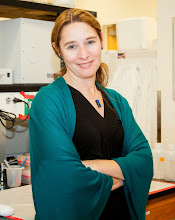 |
| From http://planninga-from-nanninga.blogspot.com |
Grab your audience’s attention with an unexpected
twist! I recently attended a workshop on
writing successful grant proposals (highly recommended!), and the presenter, Dr.Peg AtKisson, used a clever trick to get us all in our seats after the lunch
break. Peg, a rock-music vocalist, briskly launched into a musical story about
cats parachuting into Borneo. We were
captivated…and quiet!
Maybe you can’t sing – there are plenty of other ways to
capture their attention! Try popping a
balloon (as one colleague did in a talk on hearing), or start your presentation from the back of the
room. Get a co-conspirator to call your
cell phone during your talk, then answer it to deliberately make a point
(perhaps about new technology, or about the distractions of cell phones). There
are thousands of ways to liven any presentation with a brief and unexpected
turn of events. What have you tried or seen?
Please comment on your favorite.
Oh, and the cat song?
It’s based on the spraying of DDT in Borneo back in the 1950s…here’s one take on the
full story.

No comments:
Post a Comment